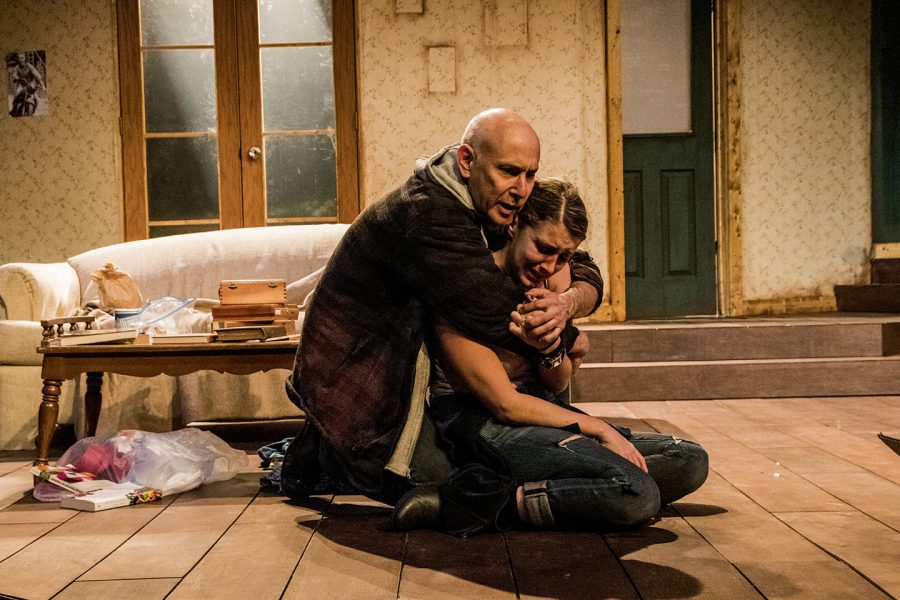“The Night Alive’s” stage, plot benefit from complexity
January 27, 2017
4.5/5 Stars
Often, we think that everything of importance happens while we are awake. However, in the dead silence of night, the seedy underbelly of society is allowed to creep out of the shadows. This is highlighted in Dobama Theatre’s production of Conor McPherson’s play, “The Night Alive”.
The play opens with very little context, as we see our protagonist, Tommy (Joel Hammer) and Aimee (Anjanette Hall) rush into Tommy’s one-room abode after Aimee was attacked by her then-boyfriend. The room, which Tommy rents from his uncle Maurice (Robert Hawkes), is filled to the brim with dirty laundry, trash bags and grimy dishes. This sets the tone for the entire show—these people are not happy in life. Some may be complacent, but in general, they exist in a constant state of squalor, living day-by-day and not thinking towards the future.
Throughout the show, we see small glimpses where we believe that the characters may be able to better themselves, only for that chance to be cruelly ripped from them by fate. Almost the instant that we see Tommy and Aimee begin to form a relationship, we meet Kenneth (Val Kozlenko), Aimee’s sociopathic ex-boyfriend, when he pays a visit to Tommy’s home. Even in the very end, when it seems that everything has turned out in Tommy’s favor, it’s all torn away in an absolutely unpredictable twist of fate.
Many aspects of Dobama’s production of “The Night Alive” work in its favor. The entire design of the theater creates a very unique experience and works well to amplify the already stunning performances by these talented actors.
One of the most unique elements of this production is the show’s lighting. From the very first scene, the audience can tell that the lighting designer, Marcus Dana, wanted to give a realistic feeling. We start with a very dimly lit stage. The audience is able to hear Tommy and Aimee arrive before seeing them. As they enter, they fumble to get the lights on in the room, fiddling with several smaller lamps and different appliances around the stage. This sense of realism is further emphasized in each scene transition. As we go from nighttime to daytime, the audience can see the lights coming from the stained-glass window shift from a cold blue to a warm yellow light seeping throughout the stage. When it is mentioned that several days pass, the crew members make drastic scenic changes, shifting the lights back and forth from day to night. Dana’s lighting design does wonders to emphasize the mood and the flow of this show.
The set for this production, with scenic design by Cameron Caley Michalak, additionally creates an incredibly detailed world within a single room. The stained glass window is one aspect of the room that stands out as a sort of anchor amidst the chaos surrounding it. As mentioned before, the stained glass adds even more dimension to the already beautiful lighting design. The window is even functional, often acting as a set of French doors for people like Kenneth and Doc (David Peacock), Tommy’s coworker and friend. Aside from the window, so much detail has been put into the rest of the set, from the nicotine stains on the walls to the organized chaos of the cluttered floors, tables and counters. It is clear Michalak put an immense amount of effort into making this home look worn-down.
The actors and the direction taken in this production create incredibly complex dynamics between the characters. One of the best examples of this is Hall’s portrayal of Aimee, who is essentially a young prostitute trying to make her way in a world that seems to be set against her. Hall shows a nuanced interpretation, showing Aimee’s split goals, wanting to be with Tommy but not wanting to hold him back.
If I had any complaints, I would say that some of the fight choreography could have been handled better. When an assailant’s fist is more than two feet away from their target when it “lands”, not even the back row audience members will be convinced. In addition, the surprise conclusion can be a bit shocking to some people.
In the end, I believe that Dobama Theatre’s artistic director, Nathan Motta, says it best in his foreword, “Amidst the dreariness, there is the warmth of human connection.” “The Night Alive” is both heartbreaking and heartwarming, and will leave you with much to think about.


